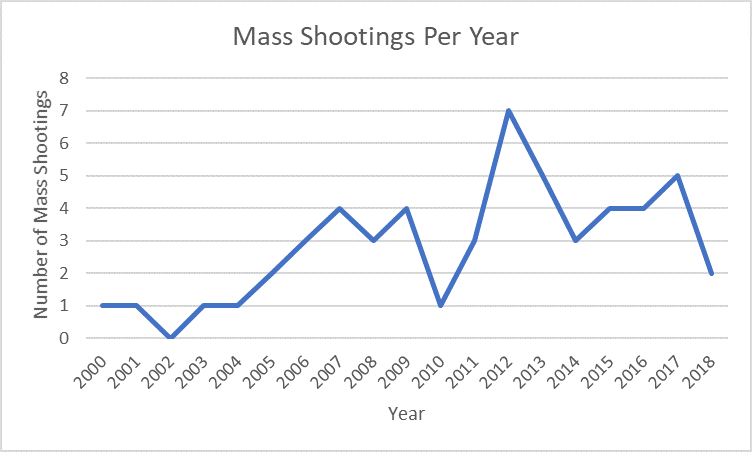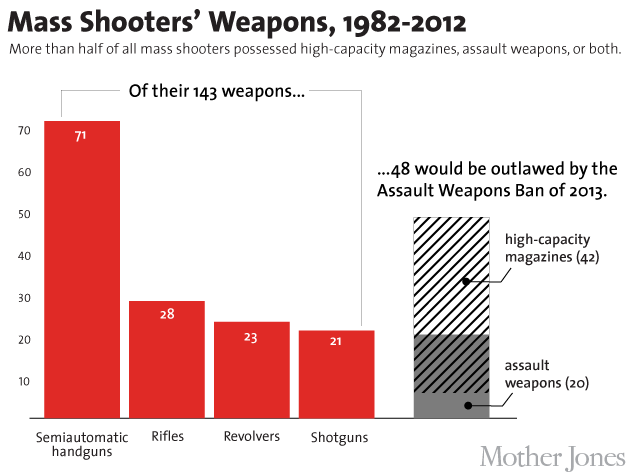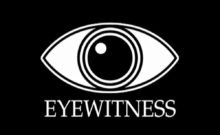So, I’m probably going to come across as callous in this post. It’s not because I want to be, but I’m looking at numbers related to shootings and death, and I want to be frank about what the numbers mean.
Since the turn of the century, according to Mother Jones, 542 people have died in 54 separate mass shootings in the United States. A mass shooting, as defined by the federal government prior to 2013 was a shooting event where the shooter chose targets somewhat indescribably and killed at least four people. In 2013, that number was revised down to 3 fatalities. Because I’m looking at data from before and after that point, I have eliminated all 3-fatality mass shootings from the data to keep a consistent frame of reference.1
Some quick facts:
Two shootings, the Pulse Nightclub Shooting and the Las Vegas Shooting account for almost 20 percent of fatalities across this period. The top 10 most deadly shootings account for 262 deaths, or roughly 48 percent of all deaths, meaning that 18.5 percent of mass shootings have accounted for almost half of all deaths in mass shootings over the past 18 years.
The median number of deaths in a mass shooting is 6.5.
 And the number of mass shootings is on the rise. We do need to figure out how to reverse this trend.
And the number of mass shootings is on the rise. We do need to figure out how to reverse this trend.
And that should start with a discussion about mental health.
Of the 54 mass shooters in the past 18 years, 29 had confirmed mental health problems prior to the shooting (roughly 54 percent), with an additional 14 falling into the “unknown” or “unclear” category (roughly 26 percent).
Mental health absolutely needs to be discussed in this context, as at least 1 in 2 mass shooters, or as many as 4 out of 5, had previously-established mental health issues. More needs to be done to keep mentally-ill people from getting access to guns.
We also need to talk about the weapons being used.
Take a look at this graphic from Mother Jones:
 Almost half of all weapons used were semiautomatic handguns. Legislation designed to reduce the number of mass shootings by banning high-capacity magazines or assault weapons would have been effective in less than a third of the shootings that have taken place over the last 30 years.
Almost half of all weapons used were semiautomatic handguns. Legislation designed to reduce the number of mass shootings by banning high-capacity magazines or assault weapons would have been effective in less than a third of the shootings that have taken place over the last 30 years.
But, before we start passing legislation, we’re going to have to face up to some harsh truths about the world in which we live. As sad as it is, mass shootings don’t even begin to stretch the surface when it comes to homicides in America.
In the past 18 years, 542 people died to mass shooters.
In 2015, 437 people died after being struck with a blunt object. That’s just one year.2
In the same year, 1544 people died after being stabbed with a knife or other cutting device.
But, even if we took all weapons and all potential weapons away, people would murder other people. In 2015, 624 people died after being beaten with hands, fists, feet, or other parts of the body. That’s more people in one year than were killed in the past eighteen by mass shooters.
Make sure you hear me clearly. Mass shootings are a problem.
But, 6447 people were murdered with handguns in 2015. To put that number in context, that’s 67 percent of all murders by gun in that year.3 Frustratingly, we don’t hear the same kind of rhetoric around handguns that we do about the kinds of weapons that the media loves to cover, despite the fact that they are involved in far fewer murders. We need to make sure that when we try to solve gun violence that we are acting proactively instead of reactively.
So, with all of the context I’ve just given you, I’m now going to talk about the Handgun Black Market. People who lawfully own guns commit less than one-fifth of gun crimes, while around four-fifths are committed by people who illegally possess the gun.
Consequently, it seems like a good way to reduce gun violence would be to stop people from getting guns illegally.
So, how do they do it?
It’s a hard area to research, as those getting the illegal guns are not filling out paperwork along the way.
One interesting method is to survey current inmates (paywall) who had a gun illegally when they were arrested at some point in time, though that was not necessarily the reason they were in jail.
A common response was the use of straw purchases, where a person who can legally purchase firearms buys some and then illegally resells or gifts them to people who would not qualify to buy them themselves. Another was that people would travel out of state to purchase weapons in areas with fewer restrictions. Sometimes the inmates believe they are stolen or that “crooked offices put guns back on the streets.”
But, how much of this is true?
It’s really, really hard to say. I’ve looked at a number of studies, and they disagree wildly about where the illegal guns come from, to the point that I’m afraid to make generalizations. Some suggest that the majority of guns are gotten from individuals in a desperate pinch, while others suggest that gun shops and licensed dealers are a much bigger source.
I hate leaving all of you without offering any kind of solid solution to this problem, but what I have is a lack of facts. I’m not sure how people get guns illegally, so anything I suggest would be conjecture. And if there’s one thing I know we absolutely cannot do, it is to create legislation that’s based on conjecture instead of facts.
If you enjoyed this article, be sure to check out:
Jessica Price and the Attack of the Mansplainers
Does Your City Really Want Amazon HQ2?
The United States of Breastfeeding
- It would have been really hard to go back and find all qualifying 3-fatality mass shootings over a 13 year period.
- This stat and all immediately following stats are sourced from the FBI and can be found here: FBI UCR 2015
- The next highest category is “Firearms, type not stated,” which means that the percentage of murder by handgun might be even higher.



